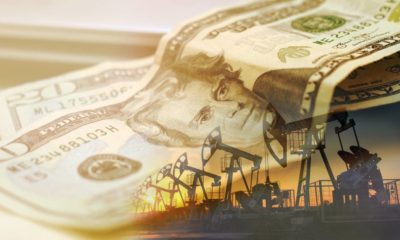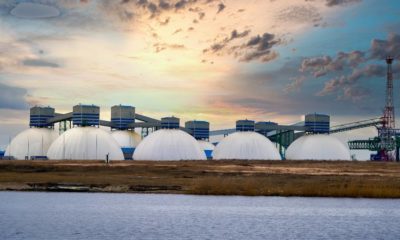bank
Market Prefers Natural Gas Over Oil

Markets reflect a preference to natural gas over oil futures and what is driving the trend.
All indicators point to another quarter of lackluster performance for the crude oil markets.
However, there has been a positive optimism shown towards natural gas in the last six months.
Clear indication for its preference over coal and oil is driven by a few factors.
Weather, Mexican demand and production shortfalls.
The markets are reflecting several factors that are influencing the figures.
There is foreign demand for US gas coming from Mexico.
The proximity of the resources keeps the prices accessible and is favored for consumption in southern countries.
The warmer weather expected in the US will inflate the need for power.
EIA (Energy Information Administration) data shows that, even though total stocks are standing at 2.972 trillion cubic feet, which is 660 billion cubic feet more than 12 months ago, it is still 80 billion cubic feet below that which was predicted by analysts.
Even while there is increased demand, production has failed to address that.
[ms_divider style=”normal” align=”left” width=”100%” margin_top=”30″ margin_bottom=”30″ border_size=”5″ border_color=”#f2f2f2″ icon=”” class=”” id=””][/ms_divider]
[ms_featurebox style=”4″ title_font_size=”18″ title_color=”#2b2b2b” icon_circle=”no” icon_size=”46″ title=”Recommended Link” icon=”” alignment=”left” icon_animation_type=”” icon_color=”” icon_background_color=”” icon_border_color=”” icon_border_width=”0″ flip_icon=”none” spinning_icon=”no” icon_image=”” icon_image_width=”0″ icon_image_height=”” link_url=”https://offers.thecapitalist.com/p/58-billion-stock-steal/index” link_target=”_blank” link_text=”Click Here To Find Out What It Is…” link_color=”#4885bf” content_color=”” content_box_background_color=”” class=”” id=””]This one stock is quietly earning 100s of percent in the gold bull market. It's already up 294% [/ms_featurebox]
[ms_divider style=”normal” align=”left” width=”100%” margin_top=”30″ margin_bottom=”30″ border_size=”5″ border_color=”#f2f2f2″ icon=”” class=”” id=””][/ms_divider]
Coal is not the new black. Factors behind the flatline.
However, the demand for coal has remained stagnant.
Coal has priced itself out of the competition.
The choice to power the US homes this summer is natural gas, and this is expected to remain unchanged for the next three months.
Whether US consumers continue to prefer natural gas over coal to power their heating systems and not just their air conditioners will be subject to production and prices in ensuing months.
The chart for coal consumption below shows the markets trend towards the mild usage.
This is further reflected by the increase in natural gas.

A clear picture is emerging for natural gas
With the production levels of natural gas remaining below the expected consumer driven demand, the prices will rise accordingly.
But it is still priced cheaply enough to remain a desirable choice for the power sector natural gas consumption.
Energy suppliers for homes in the summer heat prefer natural gas.
With summertime comes that threat of natural weather patterns that might disrupt the production and supply of natural gas.
Looking at the forecasts for both, it is necessary to gauge the chances of severe Gulf weather causing a disruption in the output and subsequent fall in supply.
This is a precaution that is always needed when factoring in Gulf weather patterns.
Storms in the Atlantic have so far passed without disruption.
The tropical weather systems expected during the hurricane season will continue to drive up the price of natural gas in expectation of possible disruption.
Stockpiles of crude oil are falling in the face of increased production.
It has not been announced yet if US producers will continue to produce more or follow the global trend of reduced outflow.
Reporting on this financial news – Myra. P. Saefong, Markets/Commodities Reporter with Biman Mukherji from Marketwatch – recently addressed this trend.
It states in the article the reasons behind the continued rise in consumer demand and the reflected optimistic pricing of natural gas.
Comparing the chart below to the one above showing the indicators for coal consumption, the trend in the upward swing for natural gas is apparent.

Outside of market influence, some independent thinkers are of the opinion that possibly turning to natural gas choices and options may be swayed by the inherent naturalness of gas as opposed to the emissions culminating from coal and oil.
Politically, natural gas may be fundamental in breaking the stranglehold that unreliable sources in foreign countries wield.
Predicting trends and analyzing alternative energy desirables is increasingly important as those markets are not sustainable for any long term forecasts.
This leads to the exchange being effected by weather, politics and demand.
Interlinked to the weather is the unpredictability of decisive forecasting.
If the supply of any product (in this case natural gas) is already understocked in the face of increased demand, this will drive up the desirability of the commodity.
The oil markets have been hit by political unrest in Nigeria.
This leads to several factors coming into focus that are linked to that market.
The supply is effected so alternate energy sources will be focused on as a solution to the Western summertime demands.
There is a growing reluctance to rely solely on oil, and this is reflected in the markets.
Globally, alternate energy sources are being embraced as a necessity, and this is showing in the consumption and price of coal and oil being brought into question.
A cautious approach to sustainability for all energy supplies is strictly monitored by the EIA.
Taking all these factors into consideration complete the global picture for natural gas marketing trends.
The general sway of opinion tends to back up the consensus that natural gas will continue on its current path for some months to come.















